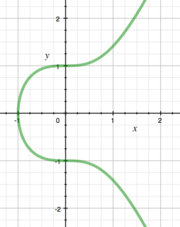
Mordell curve
Encyclopedia

Algebra
Algebra is the branch of mathematics concerning the study of the rules of operations and relations, and the constructions and concepts arising from them, including terms, polynomials, equations and algebraic structures...
, a Mordell curve is an elliptic curve
Elliptic curve
In mathematics, an elliptic curve is a smooth, projective algebraic curve of genus one, on which there is a specified point O. An elliptic curve is in fact an abelian variety — that is, it has a multiplication defined algebraically with respect to which it is a group — and O serves as the identity...
of the form y2 = x3 + n, where n is an integer
Integer
The integers are formed by the natural numbers together with the negatives of the non-zero natural numbers .They are known as Positive and Negative Integers respectively...
and where n ≠ 0. In Mordell curves, if (x, y) is a solution, it therefore follows that (x, -y) is as well.
These curves were closely studied by Louis Mordell
Louis Mordell
Louis Joel Mordell was a British mathematician, known for pioneering research in number theory. He was born in Philadelphia, USA, in a Jewish family of Lithuanian extraction...
, from the point of view of determining their integer points. He showed that for n fixed there are only finitely many solutions (x, y) in integers.
There are certain values for n in a Mordell curve in which the equation gives no integer solutions, these values are 6, 7, 11, 13, 14, 20, 21, 23, 29, 32, 34, 39, 42...
In other words, the differences of perfect squares
Square number
In mathematics, a square number, sometimes also called a perfect square, is an integer that is the square of an integer; in other words, it is the product of some integer with itself...
and perfect cubes tend to ∞. The question of how fast was dealt with in principle by Baker's method. Hypothetically this issue is dealt with by Marshall Hall's conjecture
Marshall Hall's conjecture
In mathematics, Marshall Hall's conjecture is an open question, , on the differences between perfect squares and perfect cubes. Aside from the case of a perfect sixth power, it asserts that a perfect square m2 and a perfect cube n3 must lie a substantial distance apart...
.

